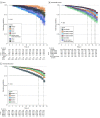Association of Demographic and Socioeconomic Indicators With the Use of Wearable Devices Among Children
- PMID: 36995714
- PMCID: PMC10064258
- DOI: 10.1001/jamanetworkopen.2023.5681
Association of Demographic and Socioeconomic Indicators With the Use of Wearable Devices Among Children
Abstract
Importance: The use of consumer-grade wearable devices for collecting data for biomedical research may be associated with social determinants of health (SDoHs) linked to people's understanding of and willingness to join and remain engaged in remote health studies.
Objective: To examine whether demographic and socioeconomic indicators are associated with willingness to join a wearable device study and adherence to wearable data collection in children.
Design, setting, and participants: This cohort study used wearable device usage data collected from 10 414 participants (aged 11-13 years) at the year-2 follow-up (2018-2020) of the ongoing Adolescent Brain and Cognitive Development (ABCD) Study, performed at 21 sites across the United States. Data were analyzed from November 2021 to July 2022.
Main outcomes and measures: The 2 primary outcomes were (1) participant retention in the wearable device substudy and (2) total device wear time during the 21-day observation period. Associations between the primary end points and sociodemographic and economic indicators were examined.
Results: The mean (SD) age of the 10 414 participants was 12.00 (0.72) years, with 5444 (52.3%) male participants. Overall, 1424 participants (13.7%) were Black; 2048 (19.7%), Hispanic; and 5615 (53.9%) White. Substantial differences were observed between the cohort that participated and shared wearable device data (wearable device cohort [WDC]; 7424 participants [71.3%]) compared with those who did not participate or share data (no wearable device cohort [NWDC]; 2900 participants [28.7%]). Black children were significantly underrepresented (-59%) in the WDC (847 [11.4%]) compared with the NWDC (577 [19.3%]; P < .001). In contrast, White children were overrepresented (+132%) in the WDC (4301 [57.9%]) vs the NWDC (1314 [43.9%]; P < .001). Children from low-income households (<$24 999) were significantly underrepresented in WDC (638 [8.6%]) compared with NWDC (492 [16.5%]; P < .001). Overall, Black children were retained for a substantially shorter duration (16 days; 95% CI, 14-17 days) compared with White children (21 days; 95% CI, 21-21 days; P < .001) in the wearable device substudy. In addition, total device wear time during the observation was notably different between Black vs White children (β = -43.00 hours; 95% CI, -55.11 to -30.88 hours; P < .001).
Conclusions and relevance: In this cohort study, large-scale wearable device data collected from children showed considerable differences between White and Black children in terms of enrollment and daily wear time. While wearable devices provide an opportunity for real-time, high-frequency contextual monitoring of individuals' health, future studies should account for and address considerable representational bias in wearable data collection associated with demographic and SDoH factors.
Conflict of interest statement
Figures



Similar articles
-
Engagement With Daily Symptom Reporting, Passive Smartphone Sensing, and Wearable Device Data Collection During Chemotherapy: Longitudinal Observational Study.JMIR Cancer. 2024 Dec 10;10:e57347. doi: 10.2196/57347. JMIR Cancer. 2024. PMID: 39656513 Free PMC article.
-
Willingness to Share Wearable Device Data for Research Among Mechanical Turk Workers: Web-Based Survey Study.J Med Internet Res. 2021 Oct 21;23(10):e19789. doi: 10.2196/19789. J Med Internet Res. 2021. PMID: 34673528 Free PMC article.
-
Wearable device signals and home blood pressure data across age, sex, race, ethnicity, and clinical phenotypes in the Michigan Predictive Activity & Clinical Trajectories in Health (MIPACT) study: a prospective, community-based observational study.Lancet Digit Health. 2021 Nov;3(11):e707-e715. doi: 10.1016/S2589-7500(21)00138-2. Lancet Digit Health. 2021. PMID: 34711377
-
Evaluation of Social Determinants of Health and Prostate Cancer Outcomes Among Black and White Patients: A Systematic Review and Meta-analysis.JAMA Netw Open. 2023 Jan 3;6(1):e2250416. doi: 10.1001/jamanetworkopen.2022.50416. JAMA Netw Open. 2023. PMID: 36630135 Free PMC article.
-
Current, future and potential use of mobile and wearable technologies and social media data in the ABCD study to increase understanding of contributors to child health.Dev Cogn Neurosci. 2018 Aug;32:121-129. doi: 10.1016/j.dcn.2018.03.008. Epub 2018 Mar 28. Dev Cogn Neurosci. 2018. PMID: 29636283 Free PMC article. Review.
Cited by
-
Usage Trends and Data Sharing Practices of Healthcare Wearable Devices Among US Adults: Cross-Sectional Study.J Med Internet Res. 2025 Feb 21;27:e63879. doi: 10.2196/63879. J Med Internet Res. 2025. PMID: 39982763 Free PMC article.
-
Characteristics and Attitudes of Wearable Device Users and Nonusers in a Large Health Care System.J Am Heart Assoc. 2024 Jan 2;13(1):e032126. doi: 10.1161/JAHA.123.032126. Epub 2023 Dec 29. J Am Heart Assoc. 2024. PMID: 38156452 Free PMC article.
-
The impact of physical activity on substance use experimentation and initiation among adolescents: Results from the ABCD Study® cohort.Drug Alcohol Depend Rep. 2025 Aug 18;16:100373. doi: 10.1016/j.dadr.2025.100373. eCollection 2025 Sep. Drug Alcohol Depend Rep. 2025. PMID: 40909199 Free PMC article.
-
Changes in Rest-Activity Rhythms in Adolescents as They Age: Associations With Brain and Behavioral Changes in the ABCD Study.J Am Acad Child Adolesc Psychiatry. 2025 Sep;64(9):1056-1067. doi: 10.1016/j.jaac.2024.11.005. Epub 2024 Nov 11. J Am Acad Child Adolesc Psychiatry. 2025. PMID: 39537024
-
Race, Ethnicity, and Sleep in US Children.JAMA Netw Open. 2024 Dec 2;7(12):e2449861. doi: 10.1001/jamanetworkopen.2024.49861. JAMA Netw Open. 2024. PMID: 39656455 Free PMC article.
References
-
- Vogels EA. About one-in-five Americans use a smart watch or fitness tracker. Pew Research Center. Published January 9, 2020. Accessed May 18, 2022. https://www.pewresearch.org/fact-tank/2020/01/09/about-one-in-five-ameri...

